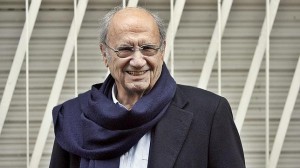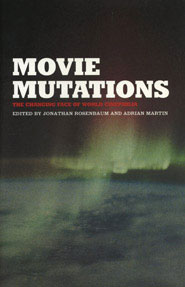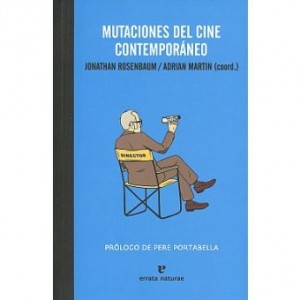Four years ago, I requested and received authorization from Pere Portabella to publish in English translation two lengthy texts of his — a lecture that he gave in 2009 when he was awarded an honorary doctoral degree by the Universidad Autónoma of Barcelona and the even lengthier (over twice as long) “Prologue” he wrote and published for Mutaciones del Cine Contemporáneo (2010), the Spanish translation of Movie Mutations: The Changing Face of World Cinephilia (2003), which I coedited with Adrian Martin. The first of these was an unsigned English translation that Nicole Brenez sent to me; the second was a makeshift translation hastily but generously done by two of Rob Tregenza’s students at Virginia Commonwealth University, Daniel Schofield and Caleb Plutzer.
The original plan was for both of these pieces to appear in the online journal Lola, but for a variety of reasons, this didn’t pan out, and both these texts were recently returned to me. For now, I am opting to reproduce the translation of the speech in three consecutive installments. — J.R.
II
In the early eighties, a significant about-face took place, especially in the European Union and the United States. All of the avant-garde movements’ residual ideas, or those protected under that name, were driven out, as the need for a unique form of politically correct, artistically appropriate thought was ushered in, and anything that smacked of “deconstruction” was swept away. In this sense, and within a more general context, we witnessed a swift and far-reaching process to dismantle critical thought structures that had been put in place most notably during the preceding decades. A status quo was consolidated which was determined by the laws of fashion and the market, which seems to confirm the prominence of “the dictatorship of the
spectacle market,” identified by Guy Debord.
It is in this very spot for the event at which he was awarded an Honorary Doctoral Degree that Manolo Vázquez Montalbán read a speech titled “On the global communication society’s lack of communication,” in the year of 1997, in which he declared: “My right as a citizen, even as a citizen who is an Honorary Doctor, to examine the role played by the media in attempting to steer my conscience towards the so-called general interest, which is usually a disguise for the interests of the global and local establishment.”
It is a system of solid, high-capacity, high-availability structures that gradually assimilates anything which can be digested and sold, coupled with the proper severity when it comes to putting to death everything which does not enter into or fit in with its sophisticated mechanisms of assimilation and rejection.
The limitations of the creative factor are therefore set by the needs and stimuli of the market. This is the toll which is paid for the right to access the great highway through which cultural production passes, once duly filtered in the sieve of the official certification process: clean, crisp descriptions of the facts, recognizable settings and identification of the main characters without too many difficulties, and, of course, with impeccable performances, bright lights, some mischievous verbiage and an exquisite sensitivity which provides backing and verification for the quality. At the cost of impoverishing cinema, it places the least value on what makes the medium most unique and sets it aside for the most routine and repetitive workaday usage. Everything else which falls outside of this norm can only circulate through alternative channels to this network, on a single lane with no rest areas. This is the marginal space intended for more interesting, risky and demanding forms of production, in which the plot, actors and actresses of the mainstream media are considered a nuisance. There is a search for an ethical and culturally rooted language of film open to the constant mutation of new expressive needs.
Cinema has survived up to the digital era with undisputed successes more than one hundred years after it came into being. The digital revolution is contributing advancements with an equal or greater impact than those of the Industrial Revolution. Multimedia is an interactive world with participating, multi-faceted users who take part through a computer that receives and transmits digitalized
messages which are more real than reality itself. This will transform and alter ways of working, language and perception. The advent and usage of computers makes it possible to develop many projects with interests and goals which are as wide- ranging as they are contradictory.
We are witnesses to a process that is creating a new individual and collective identity. Television shows us images of real, existing things; on the contrary, the cybernetic computer shows us imaginary images (G. Sartori). This virtual reality is a lack of reality which has been created, and which is only reality on screen. The virtual and simulations have excessively expanded the possibilities of what is real without being real.
The effects of the structural changes which were already required back in those years the globalization of the economy, favored by the advent of computers, are producing devastating effects. Computer engineers started to be hired alongside the usual analysts, with a preference for the former’s technical prestige and special sophistication for operating in accordance with the new criteria of the political and financial powers to maintain dynamic and sustained annual growth: a new space for
financial transactions outside of the productive economic, but based on it, unregulated, with the complicity of governments’ bodies of control over the world economy. Not belonging to everyone, but to enough.
So-called virtual finance is a non-reality which is only real on computer screens: imaginary finance. The effects of these simulations have excessively expanded the possibilities of the real productive economy to unbearable limits. When the bubble broke, there was no rain at all, and still today nobody knows whether or not we have hit rock-bottom. I do not even mention the destruction and collective or individual dramas created as a result of the excesses, the abuses and a lack of global ethics, because they are already in everybody’s minds.
The people are developing a digital viewpoint of both aesthetics and contents, with an unstoppable desire to take part in everything being done. This is being organized in a different way in each of their acts as consumers: individuals are becoming more and more convinced that they are immersed in a process which can be summarized as the globalization of exchanges, the universality of values and the uniqueness of forms (languages, cultures). Debate today and in the upcoming years will focus on
shifting from linear communication to cross-cutting communication in which users are the ones who control the time of narration to such an extent that they form a part of it until it becomes never-ending.
Globalization means turning any content into a product for reproduction and
consumption in all formats. If “the work” is not conceived in the understanding that it is a “product,” no communication will take place, because it will never reach the people for whom it was hypothetically intended.
It is obvious that the Europe of the European Union is a product of diversity and not of cultural specificity. The trend towards globality is that of homogenizing culture with “products” that encompass the greatest possible number of sensitivities within the market. The audiovisual and film sectors are the best-prepared and most fertile territory. The effects of these dynamics lead to great confusion. However, things are not the way some people try to make them seem, as if there were a triumph of free choice. Instead, the victory has been that of a task distribution system: what has
been reduced is not consumption, but rather creation; there are societies meant for consumption and others for production, and the most ominous factor is not the product’s homogenization, but rather the standardization of its production process. This is the most perverse part. In fact, we have gone from “culture above and at the margins of the market” (A. Malraux) to “what’s good for the economy is good for culture” (J. Lang). From a policy aimed at creators, we have moved towards cultural
companies behind the subterfuge that the policy aimed at creators ends up dictating and intervening, which led governments’ policies in the realm of culture to be limited to providing enablement for the industrial factor in culture, defending identity, consolidating the language, preserving the people’s symbolic and architectural heritage, leaving creativity to the periphery and outcast. Definitively, aid is given to get results, when what the investment should be made in is the process. Nowadays, the process is the result.
III
A few months ago in Madrid, a congress was held with the title “The Postmedia
Condition Within the Spanish Context.” It examined whether the post-media condition would delimit the state of the art within a new context characterized by the disappearance of traditional art media and the uprise of a new global hyper-medium or super-medium: computing, a computational language through which all of the old forms of media would be channeled: painting, sculpture, photography, film, all becoming ever more dependent upon a binary system supporting the entire realm of
information systems. If we were coherent with this idea of the post-media condition, perhaps from now on we should speak, as do certain critics and artists, about post-painting, post-sculpture, post-photography and postfilm. The post-media status would confer upon art (which therefore is also understood to include painting, film, photography, sculpture, music, etc.), the mission, armed with the powers granted by the current technological process coupled with the world of computing and the new social context created by mass communication media, of turning the practice of art into a new democratic, global space in which viewers are converted into active
users and consumers, and in which art, through the supposed globalization of cybernetic space, becomes a mechanism of illusionary emancipation not within reach for all individuals. This relationship is offered as a framework for creation in real time, consumption in real time and a shift from desire to the object desired in real time.
It has been said that this new post-cinema environment, which stretches from new screens and viewing devices to the immensity of the Internet, is contributing to more widespread access to creation and reception of works of fiction and documentaries; everywhere people are discussing the cybernetic democratization of resources and information, including all types of film and video materials…; despite this, sometimes people too easily forget that the fight to control broadcasters and to get licenses granted gave way to the fight for controlling production and distributing contents. Audiences have been overtaken by “users,” and the fight is no longer for
getting a larger audience, but rather for being consumed by more users, who choose one’s programs and spaces. In addition to those who produce the same contents as always, there is a multitude of offerings whose reliability ranges from none to little, with no validated verification system.
Viewers are moving farther away from traditional communication. Power is still basically on the side of those who create, disseminate and market these devices and program listings, imposing both ideological and practical restrictions on their use, with many still heavily linked to their origins.
* * *
Parallel to all of this, American movie critic Jonathan Rosenbaum has directed and coordinated the project Movie Mutations. Rosenbaum wished to create a sort of network that would make it possible to exchange ideas and fluent discussion regarding the ways in which contemporary cinema has been renewed, amongst films critics and creators around the world. The result is a set of texts and exchanges on the current paths being taken by cinema in a definitively global era.
In the early twenty-first century, corporativism, the maximization of profits and well-known narrative formulas seem to rule the world’s movie market, along with the declaration of its decadence and the end of film. Reality seems to demonstrate that contemporary film is richer and more diverse than ever. With the turn of the new century, the existence of new narrative resources, new frontiers for traditional genres, new techniques for creating film images, new geographic production spaces and new contexts and ways of viewing films have all been made apparent.
Critics and filmmakers make a stand for these mutations in contemporary cinema as obvious proof of cinema’s good health, while at the same time they support the creation of new critical communities that are able to think about the present and future of film beyond all geographic or generational frontiers.
Through this compendium of texts and theoretical exchanges, they offer us a tool which allows us to take a closer look at the changing, completely diversified outlook for today’s film production all over the planet: the new viewing systems created through DVD and home cinema devices, the role of the Internet in the future of cinema, and the worldwide proliferation of university departments dedicated to film studies and the creation of new theoretical and academic strategies, as well as contemporary art museums, cultural centers and other circuits which provide an alternative to movie theaters.
One prime example is that of Nicole Brenez, one of the authors [of Movie Mutations], when she says that “writing the history of contemporary cinema is becoming more and more difficult, as well as urgent, because, thanks to the development of new technologies and their extraordinary dissemination, to the current diversity of strategic models and to the incessant demand for images in our
society, production has skyrocketed.”
In Catalonia, there is a tradition of producing films in search of new spaces
liberated from institutional conventionalisms which backs Nicole Brenez’s claim.
And finally, bringing my speech to an end, I will use a very common device in film, the flashback:
After Viridiana, when I was out of work, producer Enzo Rizzoli hired me as a
screenwriter/dialogue writer for Il momento della veritá (The Moment of
Truth), directed by Francesco Rosi. Francesco, aware that I knew Orson Welles, asked me to set up a meeting with him. Welles invited us out to dinner at a classic Madrid restaurant. During the dinner, Rosi expressed his admiration for the “master” and, during the conversation, Welles, half-smiling as he attentively looked at the fine sirloin sitting on his plate, would answer his questions humorously, but also in a very cordial and professional manner. Then, Francesco, in ecstasy and delirious given the usual hubris and irony displayed by Orson Welles, suddenly asked what, in the “master’s” opinion, was the most important quality a person needed to have in order to become a great director like himself. Orson Welles looked up at him and responded, “Being in good physical shape, caro Francesco,” then burst into laughter worthy of the character of Falstaff in the movie Chimes at Midnight.
Thank you for your attention.
Pere Portabella, March 17, 2009




